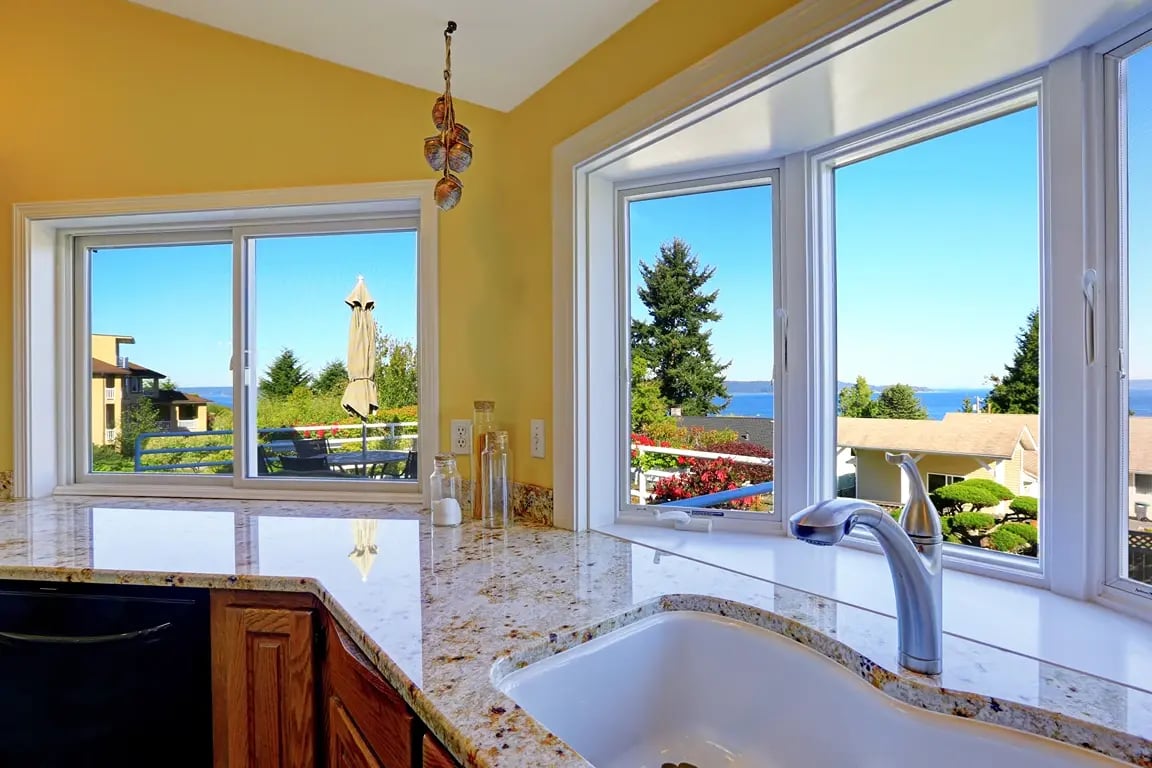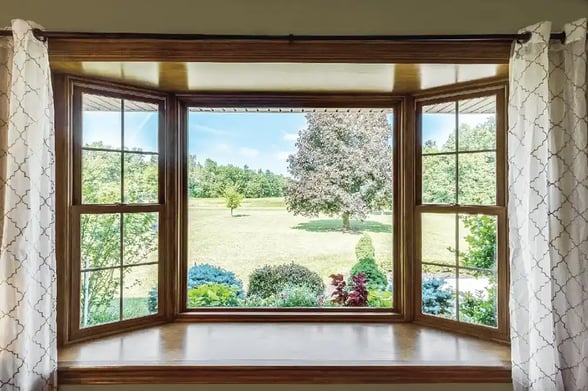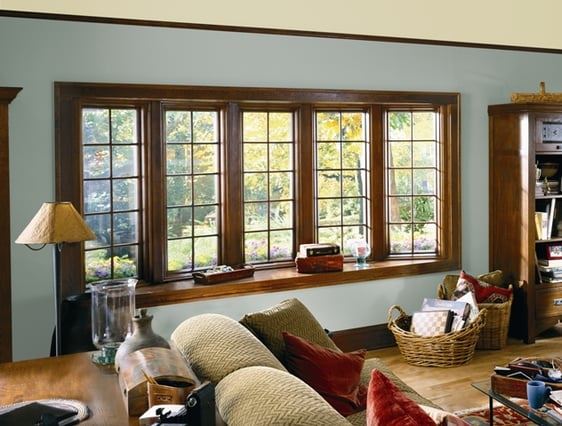Bay and bow windows bring a unique charm to any home, but how do you know which one is right for your space? While both styles can transform a room with natural light and stunning views, understanding the differences is key to finding the perfect fit for your home.
In this article, we’ll break down those key differences. From design and structure to customization options, we'll show you what sets these two styles apart so you can decide which one fits your home.
Bay Windows vs Bow Windows at a Glance
| Bay Windows | Bow Windows | |
|---|---|---|
| Space Requirements | Require less horizontal space (min. 40 inches) | Need broader wall space (min. 80 inches) |
| Room Size | Ideal for cozy living rooms or compact breakfast nooks | Suitable for larger living rooms, dining rooms, etc. |
| Number of Windows | 3 windows | 4+ windows |
| Ventilation | Operable side windows, fixed center window. | Multiple operable windows for superior airflow |
| Functionality | Ideal for kitchens and relaxing sitting areas | Perfect for living or family rooms |
| Customization | Simpler design, fewer options, budget-friendly | Greater customization, tailored elegance |
| Budget | Less expensive than bow windows but more expensive than more common options like double-hung | Higher cost, but enhances curb appeal |
Bay Windows


Bay windows immediately catch your eye, with their distinctive angular projection that sets them apart from other window styles. Typically (though not always), they consist of three windows: a large central picture window that remains fixed and two smaller, operable windows (usually casement or double-hung windows) angled at 30° or 45°. This shape creates a panoramic view, providing your room with extra light and a cozy nook for relaxing.
When it comes to size, bay windows can range from 40 inches to 6 feet wide and project outward by 1 to 4 feet. The central window is often larger than the side ones, emphasizing the impressive panoramic view they offer.
Bay windows fit seamlessly into various rooms throughout the home, each time providing a unique benefit:
- Living Room or Sitting Area: Imagine curling up with a good book in a nook filled with natural light.
- Kitchen Breakfast Nook: Brightens up your morning routine with a charming dining area.
- Bedroom: Provides extra space for a window seat or a quiet study nook.
Bow Windows

Bow windows, on the other hand, take a softer approach with a curved, semi-circular projection. They feature four or more windows of the same size and type. They're referred to by the number of windows, such as a four-lite bow, a five-lite bow or a six-lite bow.
Typically, bow windows range from 4 to 12 feet wide and project outward by 1 to 4 feet.
Just like bay windows, bow windows create inviting spaces throughout your home:
- Living Room or Family Room: Offers expansive views and abundant natural light, making the room feel larger and more open.
- Dining Room: Creates a striking focal point while providing an inviting dining space.
- Master Bedroom: Provides a luxurious, light-filled seating area or a private reading nook to unwind.
Both bay and bow windows are beautiful architectural features that add curb appeal while enhancing the natural light and space inside your home. The key difference lies in their shape and structure: bay windows create a sharper, angular projection, while bow windows offer a softer, curved look.
Where Should You Put a Bay or Bow Window?
Bay or bow windows can be a great addition throughout the house, from living rooms to bedroom.
In the living room, they create a bright, inviting atmosphere, perfect for a cozy reading nook or additional seating for guests. Kitchens also benefit from their expansive view, especially when installed above the sink to offer a lovely look at the backyard or garden. Dining rooms can be transformed into elegant breakfast nooks, offering a sunny spot for your morning coffee or a cheerful place for family dinners.
Bedrooms and home offices are also excellent candidates for bay and bow windows. A bay or bow window in your bedroom can provide a tranquil retreat where you can unwind or read a book, while a home office benefits from the refreshing view and natural light. For a striking first impression, consider installing a bay or bow window in your entryway to create a welcoming vibe that immediately catches the eye.
Wherever you decide to put these windows, they'll bring warmth, light, and charm to your living space.
Choosing Between Bay & Bow Windows
As you can see, bay and bow windows are very similar. So how do you choose between them? In this section, we'll break down the key differences and help you understand which style best suits your needs, style preferences, and living space.
Space Requirements and Room Size
- Bay Windows: If your room has limited wall space, bay windows could be the practical choice. Their triangular projection doesn’t require as much horizontal space (at least 40 inches) as bow windows.
- Bow Windows: On the other hand, bow windows require a broader wall or corner space of at least 80 inches.
Ventilation and Functionality
- Bay Windows: Typically, bay windows include operable side windows that can be opened for a fresh breeze. This makes them ideal for kitchens, where ventilation is essential, or for a relaxing sitting area.
- Bow Windows: Bow windows often have multiple operable windows, providing superior airflow and ventilation. This makes them perfect for living rooms or family rooms, where fresh air can invigorate the space.
Customization Options
- Bay Windows: With their simpler design, bay windows have fewer configuration options. This makes them easier to install and often more budget-friendly. You can customize the materials, finishes, and window types to create a unique look.
- Bow Windows: Bow windows offer greater customization possibilities since they are built into the You can choose the number of panels, window styles, and finishes to match your architectural preferences.
Budget Considerations
- Bay Windows: Generally, bay windows are less expensive due to their simpler design and fewer window panes.
- Bow Windows: Bow windows, with their multiple panes and larger size, come at a higher cost. However, the investment can be worth it for the enhanced curb appeal and luxurious feel they bring to your home.
Considering a Remodel?
If you're considering a remodel, download our Ultimate Home Remodeling Guide, where we help you budget, pick the right contractor, and prepare for your project. Alternatively, schedule a free consultation with Southwest Exteriors. We're experts in remodeling, whether you want to add a bay and bow window or enclose your front porch!

